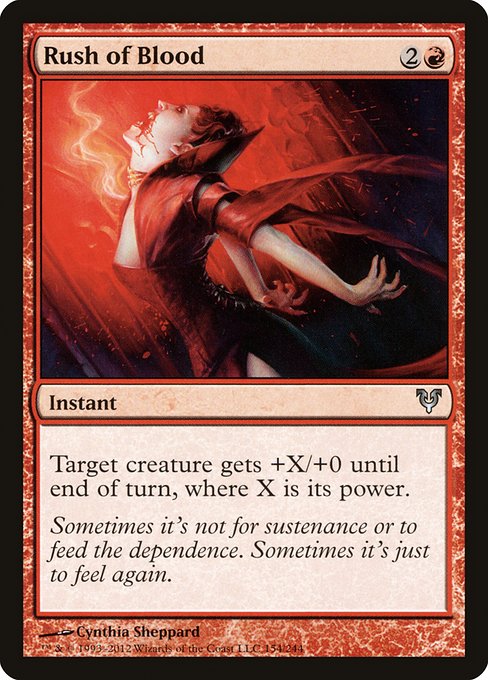
Image courtesy of Scryfall.com
Rush of Blood by the Numbers: a data-driven look at a red instant
Red has long trusted a simple premise in Magic: pressure, tempo, and surprise. Rush of Blood takes that instinct and supercharges a single creature with a dynamic boost: +X/+0 until end of turn, where X is the creature’s power. It’s an Avacyn Restored-era instant that rewards careful targeting and a touch of math. In a game where every mana matters, this spell is a quick spark—fast, flashy, and infectious with the right board state 🧙♂️🔥. Let’s visualize what this card does on the board, how its attributes shape play, and why designers and collectors alike keep this AVR uncommon in the conversation about red’s tricks ⚔️.
Card at a glance
- Name: Rush of Blood
- Mana Cost: {2}{R}
- Type: Instant
- Colors: Red
- Set: Avacyn Restored (Avr), 2012
- Rarity: Uncommon
- Text: Target creature gets +X/+0 until end of turn, where X is its power.
- Flavor Text: “Sometimes it's not for sustenance or to feed the dependence. Sometimes it's just to feel again.”
- Illustrator: Cynthia Sheppard
In practical terms, the spell is a tempo-oriented combat trick. For two mana you can push through lethal damage or force blocks you wouldn’t normally expect. The “X equals power” clause makes the buff inherently variable, tying its value directly to the target’s strength at the moment of resolution. That means a 2/2 creature becomes a 4/2 on a successful cast, while a massive creature with 5 or more power can suddenly threaten a game-changing swing. The dynamic nature of X invites a visual approach to understanding: your data viz can map power stats across your combat step to predict the peak impact of Rush of Blood on board state 🧙♂️🎲.
Visualizing the power curve
One compelling way to plot Rush of Blood is to chart the distribution of target powers across typical AVR-era red decks. A simple histogram would show how often you’re buffing a 2/2, a 3/3, or a pumped creature in a given matchup. Since the buff equals the current power, the data would reveal strategic sweet spots: targeting a 2/2 against a 2/2 creature might yield a modest +2/+0, whereas a savvy player may eye a 3/3 or higher to threaten an unexpected alpha strike. In deck-building terms, Rush of Blood rewards a creature-heavy board where the buff can reach meaningful thresholds, turning modest bodies into surprisingly resilient weapons 🔥.
Beyond raw numbers, a line chart could illustrate the relationship between mana invested and expected damage output in a typical red midrange or aggro board. You’d plot total damage potential with and without Rush of Blood across turns, highlighting the tempo gain when you cast on turn 3 or 4. The visualization becomes a narrative: a small spell that compounds with a larger creature to topple defenses and tilt the balance in your favor ⚔️💎.
Why the color and cost matter
With a mana cost of 2R, Rush of Blood sits at a sweet spot for red decks that want to pop a surprise during combat without collapsing into awkward draws. It’s an instant, so it can be played in response to blockers or as a last-burst finisher when you’re staring at a lethal swing from your opponent. The color identity, red, is all about speed and risk, and this card embodies that ethos: a precise, explosive payoff tied to the power of the moment. In a visualization, you’d highlight the tempo arc: early turns gravitating toward quick damage, midgame window where a single buff decides a clash, and late-game outcomes where the spell’s value tails off as boards stabilize 🔥🎨.
Art, lore, and the sensory cues
Avacyn Restored art direction leans into dramatic, high-contrast storytelling. Rush of Blood’s flavor text adds a psychological layer: the urge to feel something intense, to chase a sensation rather than sustenance. That human element translates well into a visual, too—the data behind Rush of Blood isn’t just numbers; it’s a story about risk, timing, and the rush of momentum. Cynthia Sheppard’s illustration anchors the card in a moment of electrified action, a reminder that even a modest instant can become a turning point on the battlefield 🧙♂️🎨.
Collector value and practical takeaways
For collectors and players alike, Rush of Blood sits in a range that reflects its status as an uncommon from a beloved block. In market terms, non-foil copies have historically hovered around modest values (Scryfall reports a current USD price around the low dollars, with foil versions edging higher). For modern collectors, the card offers both a memory trigger—Avacyn Restored’s distinctive era—and real play value in nostalgia-driven or casual red decks. If you’re into data-backed deck-building, this card provides a clear, measurable event: a boost magnitude that scales with power, not with some fixed number, which makes it a fun case study for probability and variance in a given board state 🧲.
As you embrace the visual language of MTG’s card attributes, Rush of Blood becomes a small but powerful example of how data can illuminate strategy. The card’s simplicity belies a strategic depth: choose the right moment, target the right creature, and let the power of a single boosted attack do the talking. And yes, sometimes the thrill of that moment is enough to make a player grin like a giddy mage—cracking a smile as the board explodes in red-hot momentum 🧙♂️💥.
Neoprene Mouse Pad Round Rectangular Non-Slip Colorful Desk PadMore from our network
- https://blog.rusty-articles.xyz/blog/post/aerial-responder-linking-white-lore-to-future-sets/
- https://blog.digital-vault.xyz/blog/post/parallax-uncertainty-clouds-distance-to-a-sagittarius-blue-white-giant/
- https://blog.crypto-articles.xyz/blog/post/hitmonlee-cards-that-decided-the-outcome-in-famous-tcg-matches/
- https://blog.rusty-articles.xyz/blog/post/why-energy-recycle-system-keeps-pokemon-tcg-timeless/
- https://blog.rusty-articles.xyz/blog/post/performance-heatmap-by-tournament-region-for-magcargo-in-the-pokemon-tcg/